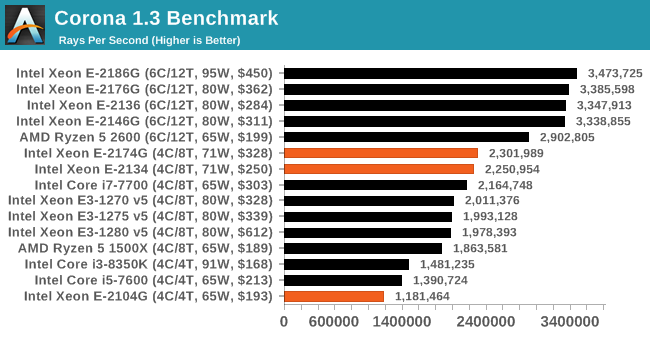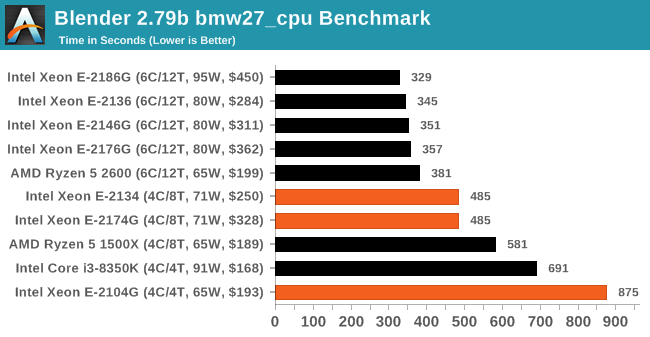The Xeon Entry Quad-Core CPU Review: Xeon E-2174G, E-2134, and E-2104G Tested
by Ian Cutress on March 11, 2019 10:30 AM EST- Posted in
- CPUs
- Xeon
- Enterprise CPUs
- Coffee Lake
- Xeon E
- C246
CPU Performance: Rendering Tests
Rendering is often a key target for processor workloads, lending itself to a professional environment. It comes in different formats as well, from 3D rendering through rasterization, such as games, or by ray tracing, and invokes the ability of the software to manage meshes, textures, collisions, aliasing, physics (in animations), and discarding unnecessary work. Most renderers offer CPU code paths, while a few use GPUs and select environments use FPGAs or dedicated ASICs. For big studios however, CPUs are still the hardware of choice.
All of our benchmark results can also be found in our benchmark engine, Bench.
Corona 1.3: Performance Render
An advanced performance based renderer for software such as 3ds Max and Cinema 4D, the Corona benchmark renders a generated scene as a standard under its 1.3 software version. Normally the GUI implementation of the benchmark shows the scene being built, and allows the user to upload the result as a ‘time to complete’.
We got in contact with the developer who gave us a command line version of the benchmark that does a direct output of results. Rather than reporting time, we report the average number of rays per second across six runs, as the performance scaling of a result per unit time is typically visually easier to understand.
The Corona benchmark website can be found at https://corona-renderer.com/benchmark

With the rendering tests, all our quad-core Xeon E processors lose out to the respective cheaper Ryzen parts.
Blender 2.79b: 3D Creation Suite
A high profile rendering tool, Blender is open-source allowing for massive amounts of configurability, and is used by a number of high-profile animation studios worldwide. The organization recently released a Blender benchmark package, a couple of weeks after we had narrowed our Blender test for our new suite, however their test can take over an hour. For our results, we run one of the sub-tests in that suite through the command line - a standard ‘bmw27’ scene in CPU only mode, and measure the time to complete the render.
Blender can be downloaded at https://www.blender.org/download/

LuxMark v3.1: LuxRender via Different Code Paths
As stated at the top, there are many different ways to process rendering data: CPU, GPU, Accelerator, and others. On top of that, there are many frameworks and APIs in which to program, depending on how the software will be used. LuxMark, a benchmark developed using the LuxRender engine, offers several different scenes and APIs.
In our test, we run the simple ‘Ball’ scene on both the C++ and OpenCL code paths, but in CPU mode. This scene starts with a rough render and slowly improves the quality over two minutes, giving a final result in what is essentially an average ‘kilorays per second’.


POV-Ray 3.7.1: Ray Tracing
The Persistence of Vision ray tracing engine is another well-known benchmarking tool, which was in a state of relative hibernation until AMD released its Zen processors, to which suddenly both Intel and AMD were submitting code to the main branch of the open source project. For our test, we use the built-in benchmark for all-cores, called from the command line.
POV-Ray can be downloaded from http://www.povray.org/

The much cheaper Ryzen 5 2600 here gets a good perf/$ boost over any of the quad-core Xeon E processors, and with the right system, can have ECC enabled.











29 Comments
View All Comments
artk2219 - Tuesday, March 12, 2019 - link
In what world is a GTX 1080 antiquated? Sure its not an RTX 2070+ but that doesn't mean its not in the same performance class. Especially since there is very little consumer software that supports raytracing.ondma - Tuesday, March 12, 2019 - link
In the world of testing *CPU* performance, where you want to most powerful gpu available to minimize gpu limitations. The 1080 is almost 3 years old, and even worse it is a vanilla 1080, not even the most powerful of its own generation, much less the new generation.bananaforscale - Saturday, March 16, 2019 - link
It's also common to all the test setups. If the GPU was changed to an RTX 2080Ti AT would have to benchmark all the systems again. Also, Xeons don't go into gaming systems, so the benefit would be questionable. Sure, you are right, but in a way that's kinda irrelevant.Foeketijn - Tuesday, March 12, 2019 - link
If only Supermicro/Tyan etc, would make an AM4 board. I would probably stop buying xeons. 24/7 build quality, IPMI, ECC and a 2D videocard and they have a new customer.I build two AM4 semi WS's and was reminded why I stopped messing around with consumer motherboards. Surprises everywhere. Bios hickups, misuse of power connections etc.
RSAUser - Monday, March 11, 2019 - link
These are Xeons, can't we add benchmarks like hosting a site and seeing how many requests it can handle? You know, things Xeons are actually used for (very rarely for gaming...)?That Wattage graph is great, no wattage/performance graph? Xeon lineup, as you stated, usually has strict power requirements, so I'd like to know the performance of those tests based on the power usage.
And why is there not Thread Ripper if that is the primary line-up these processors are competing with at that price range + ECC memory? (Even though the R5/7 seem to support ECC unofficially depending on the motherboard vendor)
SaturnusDK - Monday, March 11, 2019 - link
If in doubt. All Asrock AM4 MBs support unbuffered ECC RAM. All of them.mode_13h - Monday, March 11, 2019 - link
Thanks.GNUminex_l_cowsay - Monday, March 11, 2019 - link
Naming a level of graphics settings, IGP, was a bad idea. Frame rates in Civ6 are an uninformative metric of CPU performance, even for the purpose of playing Civ6.mczak - Monday, March 11, 2019 - link
The conclusion why the E-2104G doesn't reach its TDP is very much incorrect. Most of that delta to the other chips will be due to the low clocks (without turbo), only a small fraction of it will be due to missing HT.(And, FWIW, if you want to really see the max power, you'd also have to run a 3d app like furmark simultaneously, I don't think this was done. Possibly for the other chips it wouldn't make much of a difference, if they stick to their limits, but I'm pretty sure for the e-2104G the power draw would increase substantially. Of course though there's merit in full cpuload only power too, but this isn't the maximum the chip will use.)
mooninite - Monday, March 11, 2019 - link
You should add a section about how to buy these CPUs because they're not retail CPUs. Newegg had them listed for about a month before taking them off.Since these are marketed as workstation / entry-server chips why are there no video encoding, SQL, or Java/PHP processing benchmarks?
Video encoding in particular (VP9) using VAAPI would be helpful.